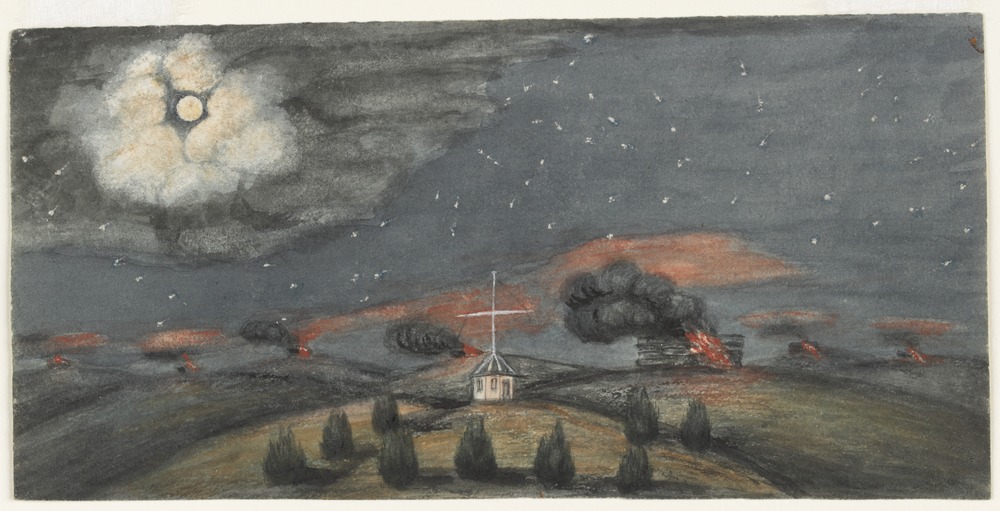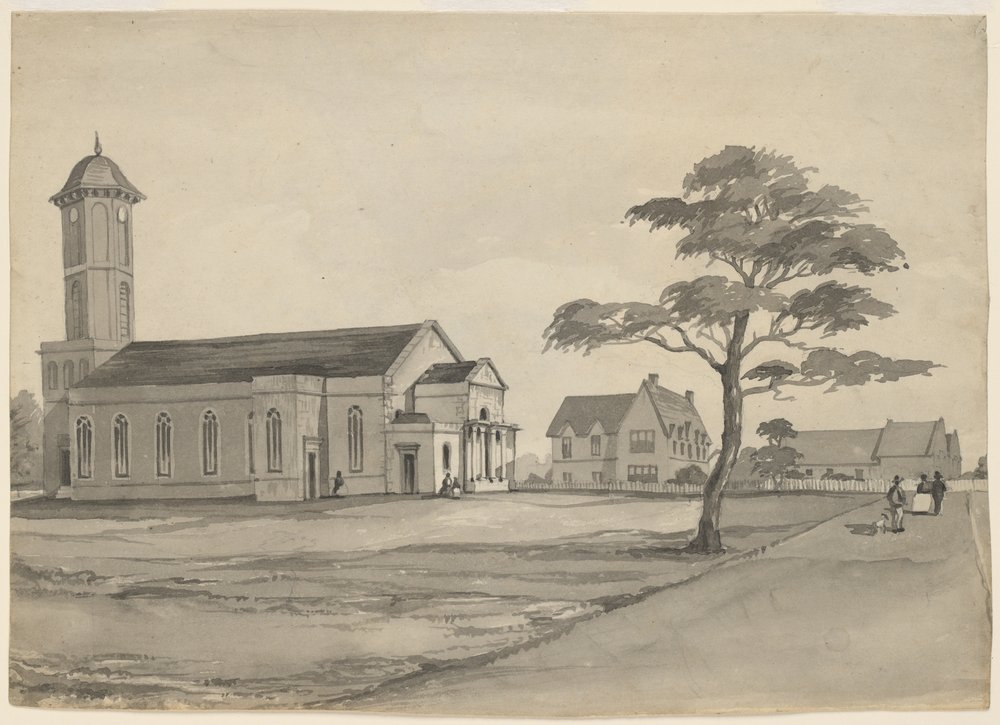Bells were once an integral part of public life. They heralded important events like births and deaths, sounded warnings against impending calamities, and rang in important public milestones, such as the separation of the Port Phillip District from New South Wales, and the funeral of explorers Burke and Wills.
 [Separation celebrations on Flagstaff Hill].Watercolour by W.F.E. Liardet; H28250/37
[Separation celebrations on Flagstaff Hill].Watercolour by W.F.E. Liardet; H28250/37
Melbourne’s first peal of six bells was installed at St James’ Old Cathedral in 1852. Victorian manufacturer, John Buncle, was tasked with hanging the bells, despite telling his manager that he ‘had never hung a bell in [his] life’. Word of the hanging of the bells soon spread, and a group of gold diggers – in town to bank their gold – gathered to watch. Amongst their number was Charles Crang, an experienced bellringer from Somersetshire, England. [1]
 St James old cathedral. Drawing by J.E.Butler; H5341
St James old cathedral. Drawing by J.E.Butler; H5341
The use of bell frames was standard practice in England [2], so Crang offered to build a frame. He gathered some timber from John Batman’s shearing shed (which stood nearby), and made a three-tier wooden frame with an additional iron frame to house the final bell. The design worked well enough, but part of the tower walls still had to be removed so that the bells had enough room to swing to and fro. [3]
When the bells were finally tested, they were so loud that Buncle fled the belfry for the sanctuary of the roof. [4]
John Buncle was lucky to have had a British bellringer on hand. Bellringing in England had a long, proud history, culminating in the seventeenth century with the invention of campanology, or ‘ringing the change.’ ‘Change ringing’ transformed the simple practice of ringing a bell into a choreographed sequence involving multiple bells.
 The bells of St. Paul’s Cathedral [Melbourne, Vic.]; A/S26/12/89/201
The bells of St. Paul’s Cathedral [Melbourne, Vic.]; A/S26/12/89/201
According to Norman Chaddock’s Manual of Bell Control, there is much more to campanology than just pulling ropes. Bellringing requires ‘a sense of rhythm, confidence, good muscular coordination, and a quick reaction time'(p. 3). Students of bellringing are required to learn the correct stance (‘face about six inches behind the free hanging rope, feet not far apart, right foot leading’), how to hold the rope (‘tail end diagonally across the palm in the left hand and in the crutch of the thumb, with a few inches to spare’ ), and how best to coil the rope to facilitate its release.(p. 5) Training for bellringing can take several months, and is generally practiced on silenced tower bells (p. 4).
In addition to the rigorous training requirements, bellringing has a lexicon all of its own. Whilst the general public understand the peal of a bell to mean a loud ringing, its meaning in campanology is much more precise. A ‘peal’ is a series of changes that must consist of no less than 5040 changes on 7 bells, or a minimum of 5,000 changes on 8 bells. It takes about three consecutive hours to ring.[5]
 St. Paul’s Church in the 1850s, which originally stood on the site of St Paul’s Cathedral. Original artist S.T.Gill; H2014.1013/186
St. Paul’s Church in the 1850s, which originally stood on the site of St Paul’s Cathedral. Original artist S.T.Gill; H2014.1013/186
In 1938, the bellringers at St Paul’s Cathedral specialised in what was known as a ‘touch’, which was a quarter of a peal, or 1250 changes. The bellringer had no chart or music score, but was required to memorise his bell’s changing order. (Herald, 24 December 1938, p. 10)
By the 1930s, the art of bellringing was ‘thriving’ in Melbourne. In accordance with English tradition, there were four main methods: the Grandsire, the Stedman, Surprise and Plain Bob, with the Grandsire method being favoured by the bellringers of St Paul’s Cathedral. To achieve a Grandsire Triple was every bellringer’s dream:
‘That Harmonious Peal called Grandsire Triples, have been ye study of ye most ingenious men undertook by John Garthou, who with long Studs and Practice have perfectly discovered these Intricate methods which were hidden from the eyes of all ringers in England’. (Herald, 24 December 1938, p.10)
 In 1963, the 13 bells from St Paul’s cathedral were sent to Britain for cleaning and retuning. Photograph courtesy of National Archives of Australia: A1200, L44574
In 1963, the 13 bells from St Paul’s cathedral were sent to Britain for cleaning and retuning. Photograph courtesy of National Archives of Australia: A1200, L44574
The first Grandsire Triple peal rang out in Melbourne on New Year’s Day in 1891. It was led by John Mottram Guest, ‘the grandfather of bellringing’ in Melbourne, who had led 19 previously unsuccessful attempts.
These days the sound of bells have been all but replaced by the din of sirens, loud music, mobile phones and car alarms, but a small group of dedicated bellringers still operate in Melbourne. If you’re lucky, you might hear them on a quiet Sunday morning, ringing in the changes of the twenty-first century.
References
[1] Buncle, John (1889?) Experiences of a Victorian manufacturer, p. 6
[2] Camp, John (1974) Bell ringing : chimes, carillons, handbells, the world of the bell and the ringer , p. 49
[3] Lewis, Hilary (1982) A history of St James old cathedral, Melbourne p. 17
[4] Buncle, op cit, p. 7
[5] Camp, John (1971) Discovering bells and bellringing


I was lucky enough to be passing through the bell chamber of St Peters church in Sandwich, Kent in July this year, on the way to the viewing tower, when the bells started to ring for midday. It was a great experience.
Fascinating information on bells. Thanks!
The picture by Gill in this article is not the Cathedral. It is the parish church of St Paul’s which stood on the site between about 1852 and 1884. It was demolished to make way for the construction of the present Cathedral, which opened in 1891.
The church also had a bell. After the demolition it was installed in the small ornamental tower on the Swanston Street side of the Cathedral. It has been automated and rings the Angelus at 12 noon every week day. It has been ringing out over Melbourne since 1852.
I am the Hon Cathedral Archivist
Thanks for the correction Dorothea. I have updated the caption accordingly. Sarah
I was captain of my village church for bell rining at age 14. I’ve ring in several venues in England and whilst doing it met some really interesting people of all ages.
Haven’t done it in over 20yrs, although did get the chance to ring a bell in Perth a couple of years ago , where they have the largest number of bells, brilliant.
I found the article fascinating. Reminded me of some of the series on television (usually British) that often showed the bell ringers ringing. It’s a real art form. Pity we can’t hear more bells – although if you sometimes in the city on Christmas morning you can sometimes hear the bells at Flinders Street Station whilst waiting for your train.
Thanks Linda. I’m glad you enjoyed it.
Hi Sarah, every time I here the church bells ringing I will recall your informative article.
John M
Thanks John!
Thanks Sarah, I enjoyed the bog post, readers might also be interested in this digital story about bells in Victorian community collections: https://victoriancollections.net.au/stories/summon-the-living
Thanks Kitty. Sarah
Gracias por la informacion!! Este tipo de blogs me parecen muy importantes, esto lo estudio en la universidad. gracias por la informacion. https://uautonoma.cl
For further stories about the history of Melbourne’s bells, check out Episode 3 of the “My Marvellous Melbourne” podcast: https://melbournehistoryworkshop.com/
It’s important to note that a peal is what Bells ring and that a set of change ringing bells is called a RING of bells. It’s a common error also made surprisingly in England.